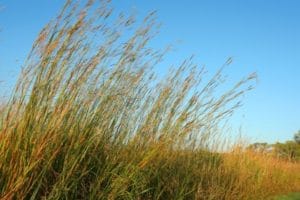Officials tout sustainability
ArgusLeader.com
by Mark Walker
Worsening drought conditions might be terrible for corn and soybean farmers but has caused minimal problems at native grass farms — one example of why prairie farmers are deeming it a more efficient and effective way of farming.

For five years, the EcoSun Prairie Farm has worked to demonstrate to agricultural producers and the general public the economic and ecological benefits of establishing grass-based farms to reproduce tall grass prairie regions which were native to the Corn Belt hundreds of years ago.
Their objectives are to demonstrate how to sustain and earn a living from products produced on restored grasslands while protecting and enhancing the natural environment.
Carter Johnson, chairperson of EcoSun Prairie Farm, said the native grass produced at the farm has seen little of the affects the dry spell is have on corn and soybeans crops.
“I’d say it’s a light impact,” he said. “They’re a little shorter because of the (lack of) rain, but these grasses are very drought adapted.”
Friday, EcoSun welcomed the public to tour the prairie farm, giving all those in attendance an overview of the project and updates on their progress.
The tour featured guest speakers who explained the significance behind the work being conducted.
“The intent in restored native tall grass to the prairie area is not only restoring the prairie area but to create a working farm that uses native perennials prairie grass,” said Pete Carrels, EcoSun marketing and outreach manager.
The farming tactics used at the prairie farm differ from the more modern agricultural practices that can be less sustainable in the long run.
Problems such as environmental degradation, ground and surface water pollution, and biocide residues are almost eliminated.
Restoring tall grass is important from an ecological standpoint, but it’s also a type of farming that is gentler on the land,” Carrels said. “It has a smaller carbon footprint, there’s less problems with water pollution and there’s less soil erosion.”
Explaining how the farm produces revenue by marketing its three primary products was a key aspect of the tour.
“We sell seed, we sell hay and we’re just starting to more explore selling cattle that we’re grazing here,” Carrels said.
Travis Petersen, grass-fed beef manager of the Co-op Natural Foods, said the organic and nonorganic grass fed beef has swiftly become increasingly popular among those practicing healthier eating habits, but the surprising taste of the meat has created a high demand that cannot yet be satisfied.
“We received high marks with the quality of our beef, we sell nearly 260 pounds of ground beef both organic and nonorganic a month,” he said. “Currently, there are just not enough suppliers of grass-fed beef to meet the demand.”
EcoSun hopes to fix this problem by becoming a model for future farms, but Wayne Smith, executive director of the South Dakota Farm Bureau, said unless the native grass industry becomes more profitable the chance of seeing more farms move to this model is unlikely.
“With $8 corn and $15 soybeans I can’t (see) a lot of changes occurring,” he said.
“Product costs would have to drop to where it wasn’t worth producing before I could see a change.”
Smith added that native grass might be more profitable in the future if it can be developed into an energy source.
Since 2008, the Prairie Farm has successfully converted 350 acres of former cropland to native grassland and has restored 30 formerly drained wetlands in the area.
Part of establishing such a successful grass farm was attributed to converting some of the most productive soil, typically only allotted to the growing of crops, in an area for native grassland.
EcoSun hopes to help restore the native grassland eco-system, which has been labeled endangered.

